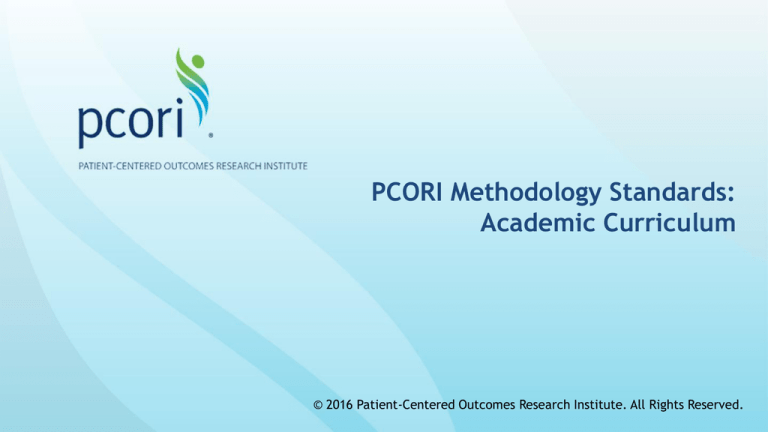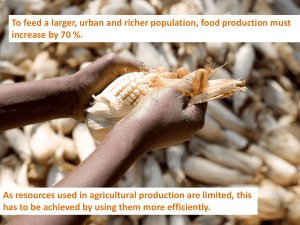
PCORI Methodology Standards:
Academic Curriculum
© 2016 Patient-Centered Outcomes Research Institute. All Rights Reserved.
Module 8: Identifying PICOTS
Elements
Category 1: Formulating
Research Questions
Prepared by Zackary Berger, MD, PhD
Eric Bass, MD, MPH
Presented by Zackary Berger, MD, PhD
Example of Writing a Question With PICOTS (Courtesy Jodi Segal, MD)
For women with diabetes newly diagnosed during pregnancy, does use of insulin or oral
sulfonylureas from time of diagnosis to delivery most decrease the risk of a large baby?
Population:
Intervention:
Comparator:
Outcome:
Timing:
Setting:
Women with gestational diabetes
Insulin
Oral drug
Big baby
During pregnancy
Not relevant
3
Population
Importance of a diverse patient population
Including previously underrepresented patient groups
Also consider:
Research gaps
Recruitment and access
Patient-powered research networks
Ethical issues regarding vulnerable/disadvantaged
populations
Impact of design on definition
• For example, inclusion criteria in database will
impact population for study
Generalizability
Image: Katyare. (2013). Via Wikimedia Commons: https://commons.wikimedia.org/wiki/File:Pencil_tips.jpeg. Licensed under the Creative Commons AttributionShare Alike 3.0 Unported license (https://creativecommons.org/licenses/by-sa/3.0/deed.en). Accessed July 15, 2015.
4
What Is the Intervention? Can It Be Better Specified?
How Would You Rephrase?
“We hypothesize that excessive variability in weight over a life time more strongly
predicts future CVD than absolute weight gain during lifetime.”
“We propose to compare serial impedance plethysmography and serial compression
ultrasonography.”
“Are individuals with diabetes who undergo bariatric surgery more likely to have
perioperative complications than individuals without diabetes who have surgery?”
“Do users of heroin do poorly when hospitalized and does the source of heroin
determine the outcomes or does race influence the outcome?”
Examples courtesy of Jodi Segal, MD.
5
Comparisons and Outcomes
Consider full range of comparisons and outcomes
“Usual care” can be an appropriate comparison, but make sure this is appropriate for
your research question
More detail is available in the “Standards Associated with Patient-Centeredness”
6
Is This a Good or Bad Comparison? Is It Patient Centered?
Comparison of planned
caesarean section versus
planned vaginal birth for
selected fetuses in the breech
presentation at term
Source: Hannah, M. E., Hannah, W. J., Hewson, S. A., Hodnett, E. D., Saigal, S., & Willan, A. R. (2000). Planned caesarean section versus planned vaginal birth for
breech presentation at term: a randomised multicentre trial. Term Breech Trial Collaborative Group. Lancet (London, England), 356(9239), 1375–1383.
Image: Johnson, M. (2008). Via Wikimedia Commons: https://commons.wikimedia.org/wiki/File:Apple_and_Orange_-_they_do_not_compare.jpg. Licensed under
the Creative Commons Attribution 2.0 Generic license (https://creativecommons.org/licenses/by/2.0/deed.en). Accessed July 15, 2015.
7
Is This a Well or Poorly Phrased Outcome? Is It Patient Centered?
“The primary outcome was perinatal or neonatal mortality at less than 28 days of age
(excluding lethal congenital anomalies), or one or more of the following measures of
serious neonatal morbidity: birth trauma, which included subdural haematoma,
intracerebral or intraventricular haemorrhage, spinal-cord injury, basal skull fracture,
peripheral-nerve injury present at discharge from hospital, or clinically significant genital
injury; seizures occurring at less than 24 h of age or requiring two or more drugs to
control them; Apgar score of less than 4 at 5 min; cord-blood base deficit of at least 15;
hypotonia for a least 2 h; stupor, decreased response to pain, or coma; intubation and
ventilation for at least 24 h; tube feeding for 4 days or more; or admission to the
neonatal intensive care unit for longer than 4 days. These definitions of serious neonatal
morbidity were identified previously by experts as important measures of term or
post-term neonatal morbidity. All reported outcomes were checked with the centres to
ensure accuracy.”
Source: Hannah, M. E., Hannah, W. J., Hewson, S. A., Hodnett, E. D., Saigal, S., & Willan, A. R. (2000). Planned caesarean section versus planned vaginal birth for
breech presentation at term: a randomised multicentre trial. Term Breech Trial Collaborative Group. Lancet (London, England), 356(9239), 1375–1383.
8
Which Time Scale Is Appropriate for These Research Questions?
Do interventions targeting neighborhood violence affect incident cardiovascular
disease more than interventions targeting physical activity?
Does provision of health food options improve cardiovascular disease outcomes more
than physical activity interventions?
Does home blood glucose monitoring increase patient adherence to other diabetes
treatment?
Does end-of-life planning improve surrogate anxiety over decision making?
First two examples courtesy Jodi Segal, MD.
9
Consider a Multiplicity of Settings
From left:
1) National Cancer Institute. (2005). Via Wikimedia Commons: https://commons.wikimedia.org/wiki/File:Doctor_examines_patient.jpg.
Public domain. Accessed July 16, 2015.
2) U.S. Navy. (2007). Via Wikimedia Commons: https://commons.wikimedia.org/wiki/File:US_Navy_070729-N-6278K272_Hospital_Corpsman_2nd_Class_Samuel_Hutcheson,_stationed_aboard_Military_Sealift_Command_hospital_ship_USNS_Comfort_%28TAH_20%29,_demonstrates_first_aid_to_community_health_care_workers_at_Casa_Comunal.jpg. Public domain. Accessed July 15, 2015.
3) Calleamanecer. (2011). Via Wikimedia Commons: https://commons.wikimedia.org/wiki/File:Clinicians_in_Intensive_Care_Unit.jpg. Licensed under Creative Commons Attribution-Share
Alike 3.0 Unported (https://creativecommons.org/licenses/by-sa/3.0/deed.en). Accessed July 15, 2015.
4) Blackwhiteupl. (2013). Via Wikimedia Commons: https://commons.wikimedia.org/wiki/File:Emergency_dispatcher_VW.jpg. Licensed under Creative Commons Attribution 3.0 Unported
(https://creativecommons.org/licenses/by/3.0/deed.en). Accessed July 15, 2015.
10


